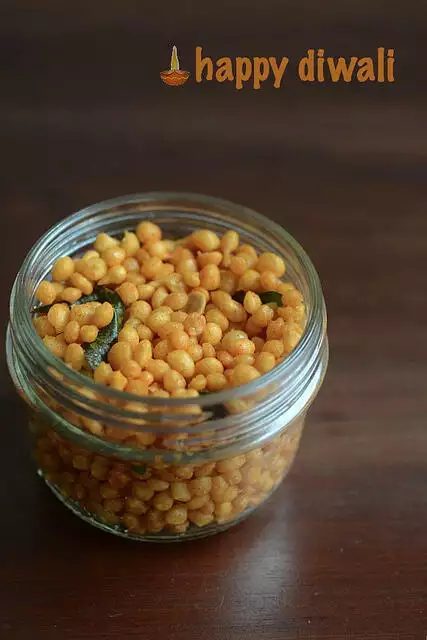
Boondi or kara boondi recipe: learn how to make boondi, the spicy kara boondi that’s a favourite and popular South Indian snack, made especially during Diwali time. With a few tips and tricks and step by step pictures, this recipe should be easy for you to prepare at home even if you are a beginner in making Diwali snacks.
The most important thing with kara boondi or even making boondi for ladoo is the consistency of the batter before frying the boondi. It has to be right to ensure that the boondi holds it’s round shape and fries up crisp for spicy boondi recipe.
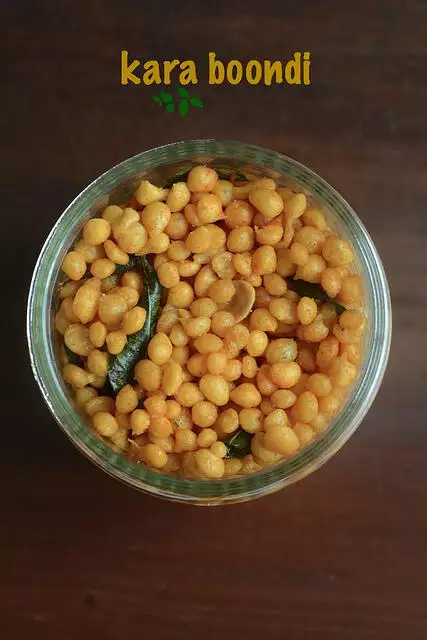
One of the tips I used and loved is from Sharmi. She suggests dipping the stem of a spoon into the boondi batter and letting it drip into hot oil to see if the boondi shape is round and perfect. When I tried this, my boondis were falling flat because the batter was too watery. I added a tablespoon of besan and it was perfect after that.
Looking for more easy snack recipes? Diwali is the perfect time to make some of these crunchy and delicious snacks:
Raw rice murukku
Butter murukku
Thenkuzhal murukku
Spicy mixture recipe
Ribbon murukku
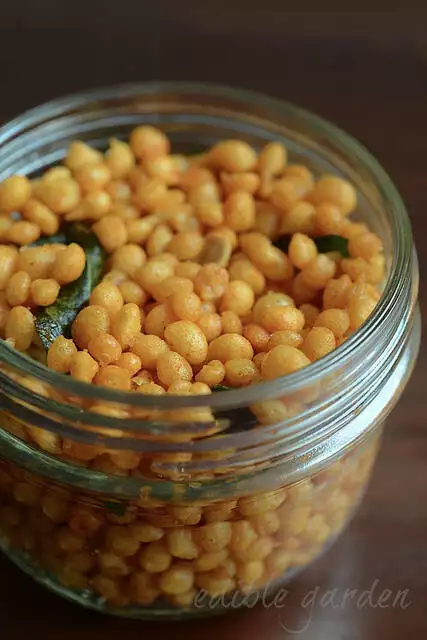
You can use a few different methods to add different flavours to spicy boondi. Garlic powder, pepper powder instead of chilli, cashew nuts or a mix of peanuts or cashews, etc. You can also add a pinch of sugar to the boondi for a blend of sweet and spicy – yum!
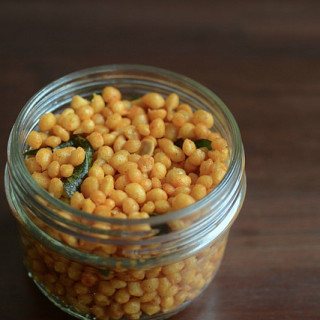
Kara Boondi Recipe
Ingredients
- 1 cup of besan gram flour
- 5 tbsp of rice flour
- 1/4 tsp of asafoetida hing, perungayam
- 1/2 tsp of red chilli powder
- 1 strand of curry leaves
- 2 tbsp of peanuts
- Salt to taste
- Oil for deep frying
Instructions
- In a bowl, mix together besan, rice flour, salt, 1/8 tsp hing, and 1/4 tsp chilli powder until well combined
- I used a whisk to ensure the powders get mixed well without any big lumps
- Add water a little at a time to get a thick batter. The right consistency is just a little more watery than bajji batter
- Heat oil for deep frying until smoking point
- Once ready, dip the stem of a spoon into the batter and let a few drops fall into the hot oil
- If the boondi turns out in round shapes, that's perfect. If the boondis are flat, the batter is too watery and to fix that, add 1-2 tsp besan. If the boondis have a tail, the batter is too thick, add more water, again very little at a time
- Once the oil and batter are ready, prepare your boondi ladle. If you don't have a boondi ladle, you can use a slotted spoon. You need two slotted spoons, one for shaping the boondis and the other for draining the boondi from the oil after frying
- Hold the boondi ladle over the hot oil and pour the batter gently over it. Don't tap or shake the ladle, just hold it steady letting the batter fall through the holes into the hot oil
- Fry the boondi until darker brown and crisp
- Drain and transfer to a bowl lined with a paper towel
- Before proceeding with the next batch, wipe the bottom of the ladle to ensure no batter is blocking the holes in the ladle
- Continue with the next batch and keep going until the batter is all done
- Wash and dry the strand of curry leaves. Ensure that the leaves are still on the stem, this makes it easier to fry the leaves
- Once done frying the boondi, turn the heat off and immediately dunk the curry leaf strand into the hot oil
- When crisp, drain and crush the leaves lightly before addind to the boondi
- Do the same with the peanuts, drain and add to the boondi
- Add the remaining 1/4 tsp chilli powder and 1/8 tsp hing as well and toss well to combine
- Cool completely and store in an airtight container for up to 4-5 days
Step by Step Pictures to Make Boondi (Spicy Version)
In a bowl, add besan, rice flour, 1/4 tsp chilli powder, 1/8 hing, and salt
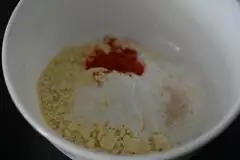
Use a whisk to mix until well combined
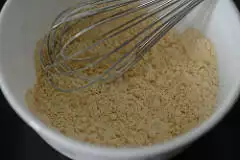
Add water at a little time
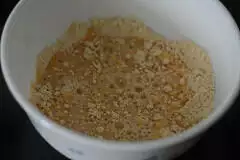
Mix well to get a thick batter that’s just slightly more watery than bajji batter
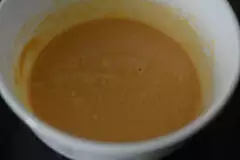
If there are any lumps in the batter, ensure you use a spoon to break them up until you get a smooth batter
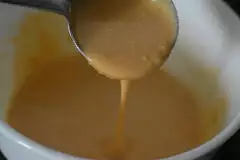
Heat oil for deep frying until smoking point. Use the stem of a spoon to dip it into the batter and let a few drops of batter into the hot oil
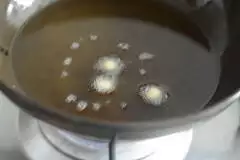
If they form perfect rounds, the batter is ready to make boondi
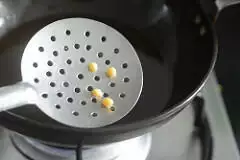
Bring our your boondi ladle
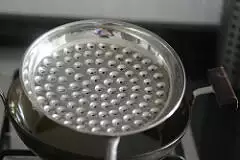
Hold over the hot oil and pour some batter gently into it, letting the boondi drops fall into the oil. Don’t shake or tap the ladle too much, just let the batter fall into the oil automatically
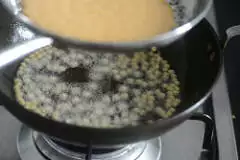
Don’t overcrowd the oil. Once there’s enough boondi to fill the pan without overlapping, you have your first batch of boondi
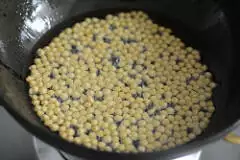
Fry the boondi stirring it occasionally
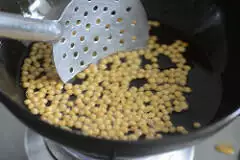
When darker brown (or lighter golden brown), drain
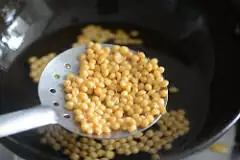
and remove to a bowl lined with a paper towel
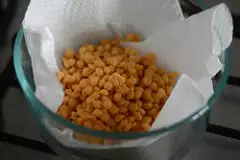
Wipe the back of the boondi ladle with a paper napkin to remove any batter that may be blocking the holes. Continue with the remaining batter
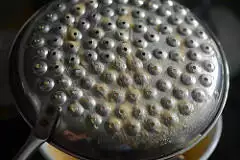
When all the batter is done. turn the heat off. Add the washed and dried curry leaf strand to the oil and remove when crisp
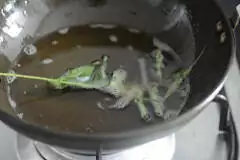
Fry the peanuts in this oil as well. The heat should be enough to turn the peanuts a light golden brown. If you want your peanuts to be more roasted, fry it before turning the heat off
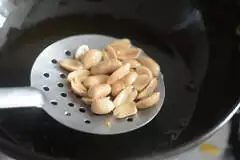
Add the curry leaves (lightly crushed), peanuts, remaining 1/4 tsp chilli and 1/8 tsp hing to the boondi
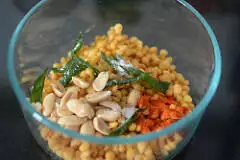
Toss thoroughly until well combined.
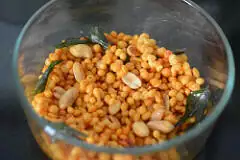
Cool the kara boondi completely before transferring to an airtight container for storage.
Notes:
– If the kara boondi turns out flat, the batter is too watery. Add a teaspoon or two of besan to make the batter thicker
– If the boondi has tails, the batter is too thick. Add more water before proceeding to fry
– You can add a pinch of sugar at the final stage for a kick of sweetness
For kara boondi recipe in Tamil, Telugu, Hindi, Marathi, Urdu, Malay, etc, please use the Google translate button in the sidebar

Is it the same procedure to make sweet boondhi too… the kara boondhi looks yummy nag and happy Diwali to u
hi there, for sweet boondi you should avoid the hing and chilli in the batter and toss the fried boondi in powdered sugar 🙂